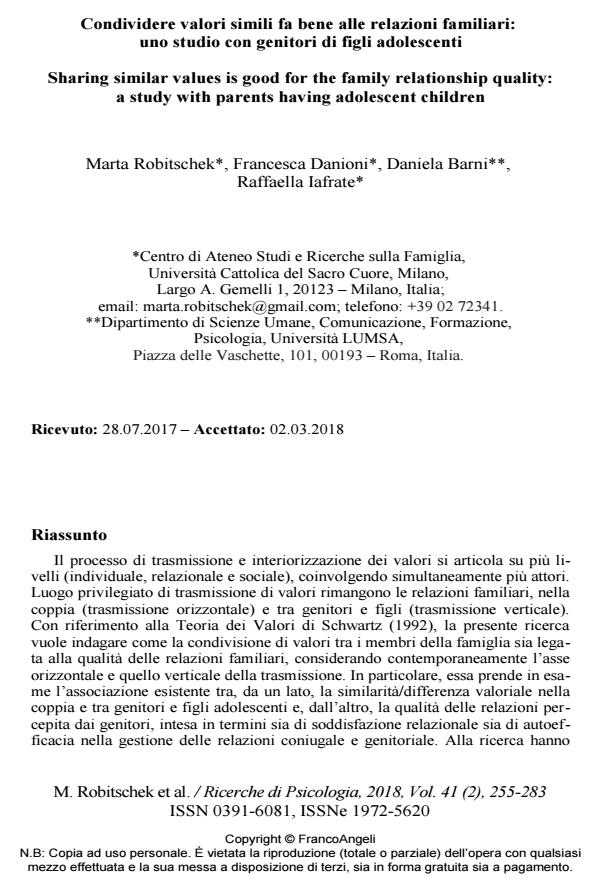Sharing similar values is good for the family relationship quality: a study with parents having adolescent children
Journal title RICERCHE DI PSICOLOGIA
Author/s Marta Robitschek, Francesca Danioni, Daniela Barni, Raffaella Iafrate
Publishing Year 2018 Issue 2018/2
Language Italian Pages 29 P. 255-283 File size 291 KB
DOI 10.3280/RIP2018-002004
DOI is like a bar code for intellectual property: to have more infomation
click here
Below, you can see the article first page
If you want to buy this article in PDF format, you can do it, following the instructions to buy download credits

FrancoAngeli is member of Publishers International Linking Association, Inc (PILA), a not-for-profit association which run the CrossRef service enabling links to and from online scholarly content.
The process of value transmission and internalization takes place on a number of levels (individual, relational and social), simultaneously involving different social actors. Family relationships are the natural forum for value transmission, namely within the couple (horizontal transmission) and from parents to children (vertical transmission). Referring to Schwartz Theory of Basic Values (1992), this research aims to investigate how sharing values among family members is associated to the quality of family relationships, considering both the horizontal and vertical axis of the transmission. In particular, the research examines the association between the value similarity/dissimilarity in the couple and between parents and adolescent children on the one hand and the quality of relations as perceived by parents considered in terms both of relational satisfaction and relational self-efficacy on the other. 381 family triads, composed of father, mother and one adolescent child (age range: 15-19 years) living in northern Italy took part to the study; each participant completed a self-report questionnaire aimed at investigating the constructs of interest. Overall, the results show how sharing values within the family, both within the couple and between parents and children, is related to a higher relational satisfaction and to a higher self-efficacy as perceived by parents. Particularly, it is family members similarity in terms of the importance given to conservation values that supports the quality of the family relations.
Keywords: Values, Family relationships, Couple similarity, Relationship satisfaction, Self-efficacy.
- “What matters to us”: The portrait values questionnaire to measure couple values Francesca Danioni, Claudia Russo, Ioana Zagrean, Camillo Regalia, Daniela Barni, in Personal Relationships /2023 pp.681
DOI: 10.1111/pere.12483
Marta Robitschek, Francesca Danioni, Daniela Barni, Raffaella Iafrate, Condividere valori simili fa bene alle relazioni familiari: uno studio con genitori di figli adolescenti in "RICERCHE DI PSICOLOGIA " 2/2018, pp 255-283, DOI: 10.3280/RIP2018-002004